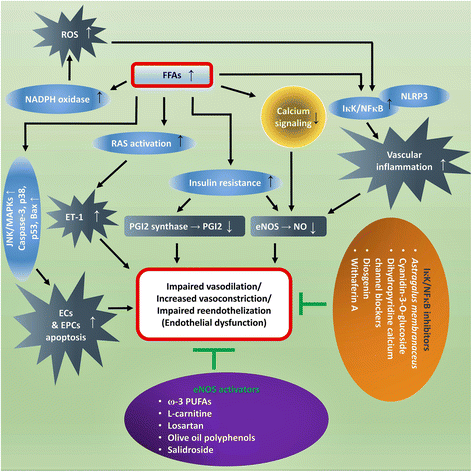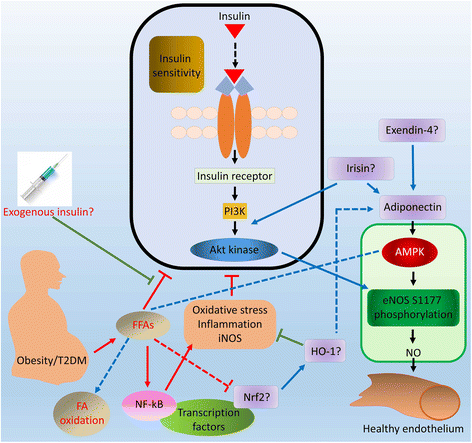Role of free fatty acids in endothelial dysfunction
- PMID: 28750629
- PMCID: PMC5530532
- DOI: 10.1186/s12929-017-0357-5
Role of free fatty acids in endothelial dysfunction
Abstract
Plasma free fatty acids levels are increased in subjects with obesity and type 2 diabetes, playing detrimental roles in the pathogenesis of atherosclerosis and cardiovascular diseases. Increasing evidence showing that dysfunction of the vascular endothelium, the inner lining of the blood vessels, is the key player in the pathogenesis of atherosclerosis. In this review, we aimed to summarize the roles and the underlying mechanisms using the evidence collected from clinical and experimental studies about free fatty acid-mediated endothelial dysfunction. Because of the multifaceted roles of plasma free fatty acids in mediating endothelial dysfunction, elevated free fatty acid level is now considered as an important link in the onset of endothelial dysfunction due to metabolic syndromes such as diabetes and obesity. Free fatty acid-mediated endothelial dysfunction involves several mechanisms including impaired insulin signaling and nitric oxide production, oxidative stress, inflammation and the activation of the renin-angiotensin system and apoptosis in the endothelial cells. Therefore, targeting the signaling pathways involved in free fatty acid-induced endothelial dysfunction could serve as a preventive approach to protect against the occurrence of endothelial dysfunction and the subsequent complications such as atherosclerosis.
Keywords: Endothelial dysfunction; Free fatty acids; Inflammation; Insulin resistance; Nitric oxide; Oxidative stress.
Conflict of interest statement
Ethics approval and consent to participate
Not applicable.
Consent for publication
Not applicable.
Competing interests
Not applicable.
Publisher’s Note
Springer Nature remains neutral with regard to jurisdictional claims in published maps and institutional affiliations.
Figures


Similar articles
-
Modulation of endothelium function by fatty acids.Mol Cell Biochem. 2022 Jan;477(1):15-38. doi: 10.1007/s11010-021-04260-9. Epub 2021 Sep 16. Mol Cell Biochem. 2022. PMID: 34529222 Free PMC article. Review.
-
The link between metabolic abnormalities and endothelial dysfunction in type 2 diabetes: an update.Basic Res Cardiol. 2012 Jan;107(1):237. doi: 10.1007/s00395-011-0237-1. Epub 2011 Dec 22. Basic Res Cardiol. 2012. PMID: 22189563 Free PMC article. Review.
-
Free fatty acids (FFA) and endothelial dysfunction; role of increased oxidative stress and inflammation. --to: Steinberg et al. (2002) Vascular function, insulin resistance and fatty acids.Diabetologia. 2003 Feb;46(2):300-1. doi: 10.1007/s00125-002-1027-y. Epub 2003 Feb 12. Diabetologia. 2003. PMID: 12627332 No abstract available.
-
Insulin resistance, lipotoxicity and endothelial dysfunction.Biochim Biophys Acta. 2010 Mar;1801(3):320-6. doi: 10.1016/j.bbalip.2009.09.025. Epub 2009 Oct 8. Biochim Biophys Acta. 2010. PMID: 19818873 Review.
-
Free fatty acid impairment of nitric oxide production in endothelial cells is mediated by IKKbeta.Arterioscler Thromb Vasc Biol. 2005 May;25(5):989-94. doi: 10.1161/01.ATV.0000160549.60980.a8. Epub 2005 Feb 24. Arterioscler Thromb Vasc Biol. 2005. PMID: 15731493
Cited by
-
The new exploration of pure total flavonoids extracted from Citrus maxima (Burm.) Merr. as a new therapeutic agent to bring health benefits for people.Front Nutr. 2022 Oct 6;9:958329. doi: 10.3389/fnut.2022.958329. eCollection 2022. Front Nutr. 2022. PMID: 36276813 Free PMC article. Review.
-
Novel Role of the ALPI Gene Associated with Constipation Caused by Complement Component 3 Deficiency.Int J Mol Sci. 2024 Sep 2;25(17):9530. doi: 10.3390/ijms25179530. Int J Mol Sci. 2024. PMID: 39273477 Free PMC article.
-
Impact of Lipids on Insulin Resistance: Insights from Human and Animal Studies.Drug Des Devel Ther. 2024 Jul 31;18:3337-3360. doi: 10.2147/DDDT.S468147. eCollection 2024. Drug Des Devel Ther. 2024. PMID: 39100221 Free PMC article. Review.
-
Impaired L-arginine metabolism marks endothelial dysfunction in CD73-deficient mice.Mol Cell Biochem. 2019 Aug;458(1-2):133-142. doi: 10.1007/s11010-019-03537-4. Epub 2019 May 15. Mol Cell Biochem. 2019. PMID: 31093850 Free PMC article.
-
Polysaccharides from natural resource: ameliorate type 2 diabetes mellitus via regulation of oxidative stress network.Front Pharmacol. 2023 Jul 11;14:1184572. doi: 10.3389/fphar.2023.1184572. eCollection 2023. Front Pharmacol. 2023. PMID: 37497112 Free PMC article. Review.
References
-
- Zapolska DD, Bryk D, Olejarz W. Trans fatty acids and atherosclerosis-effects on inflammation and endothelial function. J Nutr Food Sci. 2015;5:426. doi:10.4172/2155-9600.1000426.
Publication types
MeSH terms
Substances
LinkOut - more resources
Full Text Sources
Other Literature Sources

